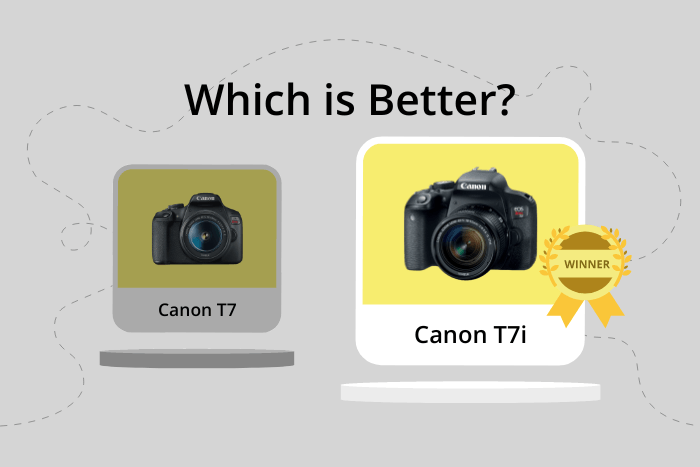Canon EOS Rebel T7 / 2000D vs EOS Rebel T7i / 800D Comparison
Canon EOS Rebel T7 / 2000D
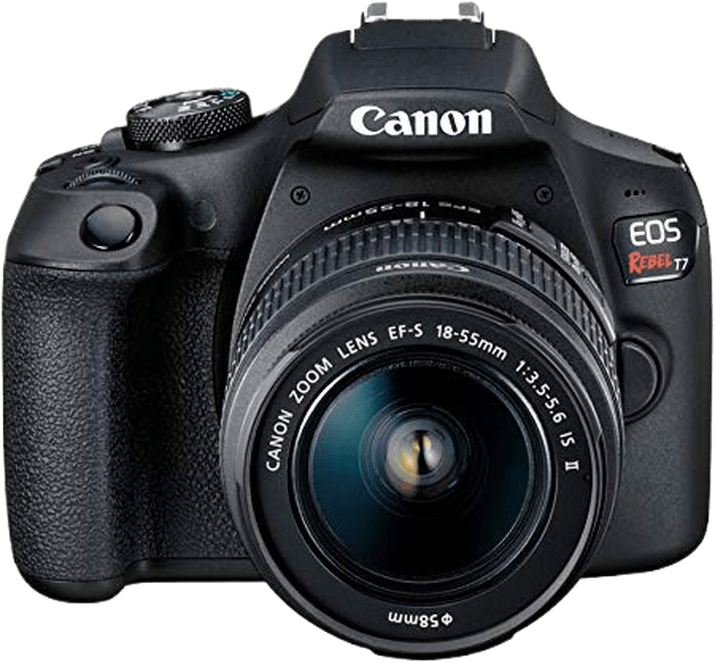
Canon EOS Rebel T7i / 800D
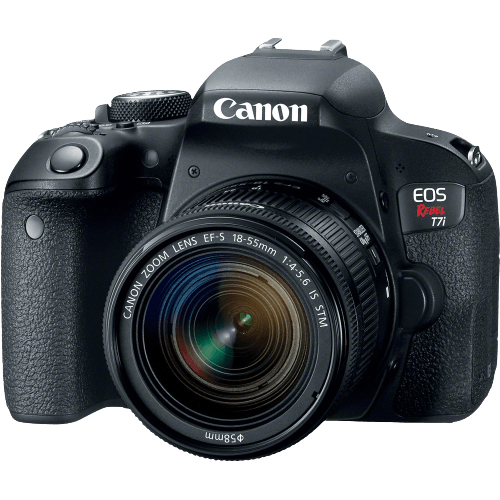
Canon T7 vs T7i Overview
Today’s contest is between the Canon EOS Rebel T7 and the Canon EOS Rebel T7i (or the EOS 2000D and EOS 800D in Europe). While their American names are similar to the point of confusion, the two cameras have some notable differences regarding specs.
We’ll tell you now, the Canon EOS Rebel T7i wins this contest. It is the pricier of the two Canon Cameras. But it’s worth spending a bit more to get the superior features of the Canon EOS Rebel T7i.

Canon EOS Rebel T7i / 800D
We’ll take you through this Canon T7 vs T7i head-to-head in every way. You’ll be able to see the benefits and pitfalls of these entry-level DLSR cameras. And you’ll be able to decide if you agree with the judge’s decision.
Body and Handling
Canon has a tradition of making DSLR cameras with well-designed, ergonomic bodies. And the Canon EOS Rebel T7 and the Canon Rebel T7i both continue that trend.
They are nearly identical in size. But the Canon EOS Rebel T7 is slightly heavier than the Rebel T7i. But the difference is less than 100 g (0.22 lb).
Canon has enough experience making DSLRs to know what people want in their hands. And the controls are well-positioned and easy to access. Both cameras have an intuitive layout, and it doesn’t take long to become second nature.
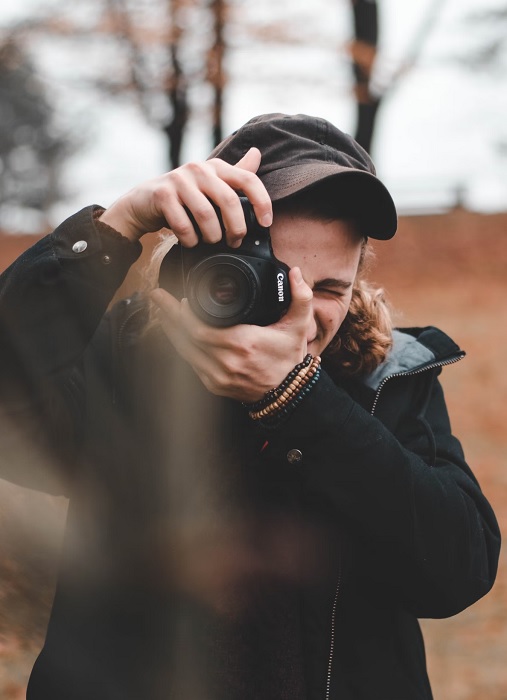
Canon T7 vs Canon T7i Optics
Now we’ll see how the DSLR cameras compare in image creation. We’ll look at their sensors, the resolution, and other camera specs important to photography.
Sensors and Resolution
Both cameras have an APS-C CMOS sensor, meaning the sensor size is the same. And they both have 6000 x 4000 px image resolution. But the Canon EOS Rebel T7 pips the Rebel T7i in megapixels. The sensor carries 24.1 MP compared to the Rebel T7i’s 24 MP.
The increase of 0.1 MP doesn’t make a world of difference. You’d have to enlarge the photos to an incredible degree to see a difference in image quality. And the two cameras have Canon’s advanced image processing engine for smooth performance.
Whether it’s 24 or 24.1 MP, that’s a fairly standard image resolution for an APS-C DSLR camera at this level. And while not groundbreaking for this sensor size, you won’t find much disappointment from users of either camera.
The Canon EOS Rebel T7 and the Canon EOS Rebel T7i both produce fantastic images. The color rendering is excellent. They’re both vivid and natural. And there’s excellent detail and dynamic range.
You’ll have no qualms using photos from the Canon EOS Rebel T7 and Rebel T7i for enlargement or print media. But manage your expectations and remember they are beginner-friendly cameras.
Low-Light Performance
The ISO range is the first thing to look at when judging cameras on their low-light performance. And this is where we see some clear differences between the two Canon cameras.
The Canon EOS Rebel T7 has an ISO range from 100 to 12,800. That’s not bad for an entry-level camera. But the Canon EOS Rebel T7i has an increased range that goes up to ISO 25,600.
The Canon EOS Rebel T7i’s 100-25,600 ISO range opens up more shooting opportunities. You can photograph wildlife at dawn, indoor sporting events, and live concerts. You will experience digital noise at the higher end. But the bigger range gives you more options when light is scarce.
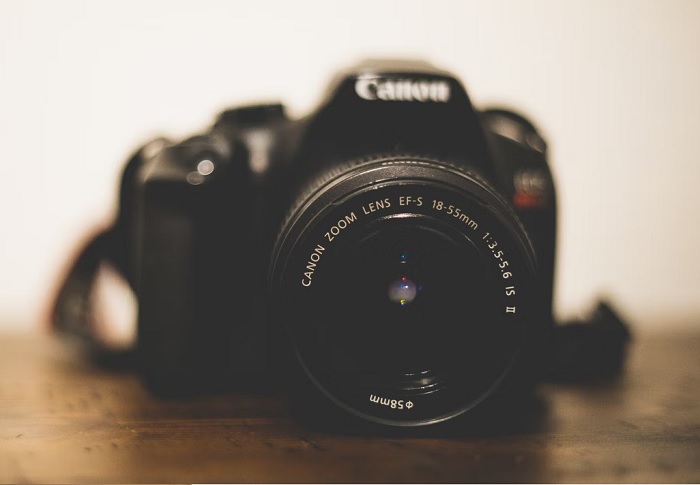
Lens Compatibility
The Canon EOS Rebel T7 and the Canon Rebel T7i both have Canon EF lens mounts. And finding out your interchangeable lens camera has an EF mount is always good news.
The EF lens mount is Canon’s most common. They have thousands of lenses in their EF series. No matter what type of lens you need, you’ll be able to find one that fits the Canon EOS Rebel T7 and the Rebel T7i. The EF mount is a big selling point for both cameras.
Optical DSLR Viewfinder
Both Canon T7 vs T7i cameras have a pentamirror optical viewfinder. It doesn’t have the quality of the pentaprism systems found in more advanced cameras. But many will appreciate the accurate visuals seen through the viewfinder.
An optical viewfinder gives you a reflection of the view seen through the lens. It’s not a digital representation like you get from electronic viewfinders. This is ideal for beginner photographers honing their craft.
Canon EOS Rebel T7 / 2000D vs EOS Rebel T7i / 800D Video Performance
On the surface, there isn’t much that separates the Canon EOS Rebel T7 and the Canon EOS Rebel T7i in the video category. But there are a few important differences when you look deeper.
The two cameras have the same max video resolution of Full HD (1080p). That’s fine for beginners. But camera buyers interested in filmmaking expect a minimum of 4K video quality.
The Full HD video on both cameras is more than enough for social media platforms. But the Canon EOS Rebel T7i has an advantage videographers will appreciate.
While the Canon EOS Rebel T7 has a Full HD frame rate of 30 fps, the Canon T7i shoots at 60 fps. The increased frame rate makes for super-smooth video quality. You’ll experience less jerking and less lag when recording and playing back videos.
The Canon EOS Rebel T7i also gives you a choice of video files. The Canon EOS Rebel T7 only allows for MOV files. But the Rebel T7i has MOV and MPEG-5 files.
Time-Lapse Video
The Canon EOS Rebel T7i takes another point against the Rebel T7. The Canon EOS Rebel T7 has no time-lapse video options built in. But the T7i has time-lapse modes as standard, making it very easy to create fantastic time-lapse videos.
Audio Recording
The Canon EOS Rebel T7i is better equipped for multimedia recording. It has an external microphone port for high-quality sound recording. It’s a 3.5 mm mini jack mic input for stereo microphone recording.
The Canon EOS Rebel T7 doesn’t have a microphone port, which is a setback in the eyes of video enthusiasts.
Webcam Capabilities
Both cameras can be used as webcams for video conferencing and livestreaming. You can connect the DSLR to your computer using a USB connection. And then you run the Canon Utility software to start streaming. That’s a bonus point for both cameras.
Canon EOS Rebel T7 / 2000D vs EOS Rebel T7i / 800D Features and Benefits
Flash
The Canon EOS Rebel T7 and Rebel T7i have strong flash options. They both have a built-in flash, allowing you to continue shooting at night without extra gear.
They also have hot shoe connections for external flashes, opening up more possibilities for additional lighting. It’s a good feature for studio photographers.
LCD Screen
The Canon EOS Rebel T7i has the better screen of the two cameras. The Rebel T7 has a fixed screen that doesn’t tilt or articulate. But the Rebel T7i has a flip-out screen that tilts and rotates. And it’s also touch sensitive.
There’s also an imbalance in screen resolution. The Canon EOS Rebel T7i has a resolution of 1.04m dots compared to the Rebel T7’s 920k dots. It’s not a huge difference, but you’ll see an increase in definition on the Rebel T7i.
Burst Mode
The Canon EOS Rebel T7i takes the biscuit for burst mode. But there isn’t a big difference. And both have a disappointing continuous shooting speed.
The 6 fps from the Rebel T7i isn’t much, but you wouldn’t expect much more from an entry-level DSLR. The Canon Rebel T7’s burst is slow and tops out at 3 fps. That’s a sluggish continuous shooting speed by anyone’s standards.
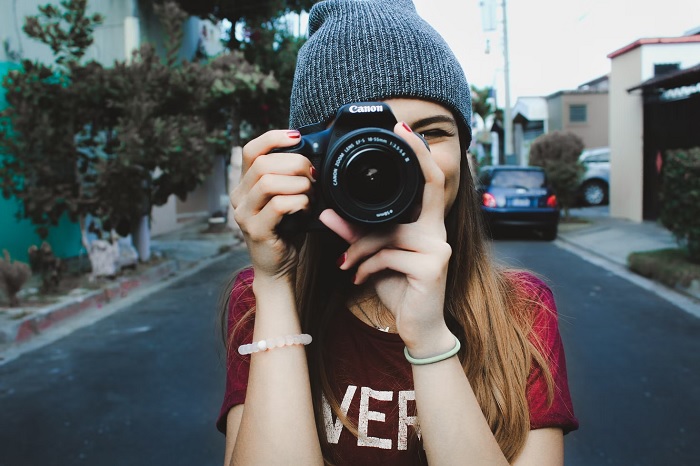
Autofocus
Autofocus is another strength of the Canon EOS Rebel T7i. It has 45 cross-type AF points spread across the frame. It’s quick to lock on to your subject. And the AI focus tracks moving subjects.
The Canon EOS Rebel T7 only has 9 cross-type AF points. It does have AF tracking. But it’s less sensitive to movement because it has fewer AF points. And the superior low-light sensitivity and dynamic range also mean the AF of the Rebel T7i is more responsive in low light.
The Rebel T7i also has more options if you want to select focus points manually. There’s single focus point selection. And there’s zone AF if you want to select several focus points in one area of the frame.
Wi-Fi and Bluetooth Connectivity
Both Rebel cameras have Wi-Fi connectivity, which is great for transferring images and sharing online. But again, the EOS Rebel T7i takes the point in this category.
As well as Wi-Fi, the Rebel T7i also has Bluetooth connectivity. Connecting with Wi-Fi is most people’s preferred method. But Bluetooth uses less energy, so you can transfer when the battery is low.
Image Stabilization
Neither DSLR camera has built-in image stabilization. While this is a tall ask for beginner cameras, image stabilization is something we’re seeing more often in lower skill level cameras.
Canon EOS Rebel T7 / 2000D vs EOS Rebel T7i / 800D Storage and Battery
Memory and Storage
The Canon EOS Rebel T7 and the Rebel T7i both have single memory card slots. This might be frustrating for trigger-happy photographers. But you generally don’t see dual card slots until you get to the professional end of the camera scale.
Battery Life
Both cameras are reliable regarding battery life. You won’t get caught short with either DSLR. But there is a difference between the two, and again, the numbers favor the Rebel T7i.
The Canon EOS Rebel T7 has a 500-shot battery life when fully charged. Not bad. But the Canon T7i has a longer battery life, giving you 600 shots from a fully charged battery. Those 100 shots can make a big difference when you’re out shooting.
Canon EOS Rebel T7 / 2000D vs EOS Rebel T7i / 800D – Our Verdict
The Canon EOS Rebel T7i is the winner against the Canon EOS Rebel T7. This Canon T7 vs T7i review reveals that they are similar cameras in many ways. But comparing each camera’s specs, the Canon T7i took a clear lead and emerged victorious.
They are both solid entry-level DSLR Canon cameras. The Canon T7 is an excellent camera for a young beginner. The image quality is fantastic and there are plenty of features to play with. But the Canon T7i has more to offer with more features and better specs in important areas.
There isn’t much of a sensor comparison because they are nearly identical. But the Canon T7i pulls ahead in video, autofocus, and low-light performance. And the tilting touchscreen is a helpful feature for snapping tricky shots.
The Canon EOS Rebel T7 is a good option if your budget is tight. But we believe the Canon EOS Rebel T7i is worth the additional cost. The superior specs and features offer more value for money.

Canon EOS Rebel T7i / 800D
Canon T7 vs T7i Alternatives
Still not sure? Check out our other popular camera comparisons:

